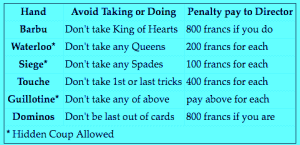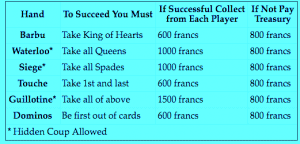OBJECTIVE OF COUP d’ETAT: Have the most money in hand at the end of the game.
NUMBER OF PLAYERS: 2+ players
NUMBER OF CARDS: Stripped 52 card deck, described below.
MATERIALS: Director’s board, Six daggers (markers), four charts, money
RANK OF CARDS: A (high), 10, K, Q, J, 9, 8, 7
TYPE OF GAME: Trick-Taking
AUDIENCE: All Ages
INTRODUCTION TO COUP d’ETAT
Coup d’état is a game of unclear origin. It is believed the game was played first by political prisoners in French dungeons over 200 years ago. The game is closely related to the French game Barbu. The phrase coup d’état translates literally to “stroke of the state,” but is understood to mean a government overthrow by political revolutionaries.
There are 6 hands in the game, each is different and must be played to complete and move to the next round. The number of rounds in the game is always equivalent to the number of active players. Players play for themselves, there are no partnerships or alliances. The winner has the most money when the game ends.
THE CARDS
Coup d’Etat utilizes a stripped standard 52 card deck. In each suit, cards A, K, Q, J, 9, 10, 8, 7 are used. In addition, there is one special card, the Coup card.
THE PREP
Each player grabs a chart and 10,000 francs (or another currency) in the following denominations: Two 2,000 francs, three 1,000 francs, five 500 francs, and five 100 francs. Place the six daggers inside the 6 holes on the Director’s board (under the “S” or start).
THE PLAY
Prior to play, the director must place the director’s board in front on them. Any player may act as director. They deal 8 cards, face-down, to each player and places the last card that remains in the middle of the table. This card must also be face-down.
Players grab their hands and begin to sort them by suit. It is paramount to keep cards secret. The player with the coup card must announce it to all other players. After, they must decide to use the coup and overthrow the director in order to become the director. If the coup card is in the center of the table, the dealer (director) must re-shuffle and re-deal the cards.
THE DIRECTOR’S CHART

HOW TO USE THE DIRECTOR’S CHART
If, for example, the player with the coup card doesn’t go for the coup, they discard the coup card and it is not used during that hand. The card is replaced with the extra card in the center. The director, after studying their hand, picks which of the six hands listed in the chart above they wish to play. They must announce their choice and move the dagger opposite to the hand on the director’s board, the dagger should be under column one. Players turn their charts to the director’s side. After, the director initiates the game by playing a single card, face-up, in the center of the table. They may play any card, following these stipulations:
- If Barbu was selected, they may not lead with a Heart.
- If Siege was selected, they may not lead with a Spade.
- If Guillotine was selected, they may not lead with a Heart OR a Spade.
After, play moves to the left. Each player plays a single card. If possible, they should follow suit. If not, they may play any card in hand. The winner of the trick is the player who played the highest ranking card that of the suit led with. The second trick is lead with by the winner. This continues until all 8 tricks have been played.
In Touche and Guillotine, players pay the director directly if they take the first and last tricks. However, the penalty payments in Barbu, Waterloo, and Siege can be paid in a lump sum at the end of the hand.
DOMINOS
In Dominos, the goal is to get other players or one other player to play their last card. Unlike the other games, the 10 is ranked between Jack and 9. In the event the director chooses dominoes, they may play any card in hand to lead the trick. The player to the left of the director must play a card either one rank higher or lower than the card led of another suit. If a player can play, they must. However, if they don’t have a playable card in hand they may pass.
COUP CHART

USING THE COUP CHART
Once the first hand has been completed, the director shuffles and deals the cards using the same mechanism as before. The coup card rules also still apply, it must be announced or the cards must be re-dealt. It is imperative to remember that one hand has already been played, so there are only five hands to choose from. If they decided to play the coup, the dagger is moved to the “1 column from the start and all players to their charts to the coup side.
To conduct a successful coup, plays must accomplish that requirements for the coup on the chart of the hand selected. This is not easy because other players will be attempting to block you. Other players are not subjected to the penalties listed on the director’s chart
If you are trying to make a coup, you have some advantages. First, they select the hand to play. Second, the lead the first trick. Lastly, the coup card is wild and will trump all other cards in a trick. Except, it cannot capture an Ace of the suit lead with.
The extra card on the table is incorporated into the trick. The winner of the first trick also takes that card.
If the player attempting the coup fails, they pay the director the penalty listed on the chart. This exchange is called the Treasury. That money goes to the player who is able to make the first successful coup, or if no players are able to do so during the game, it stays with the directors.
Players who succeed in the coup are paid out by other players according to the chart and game played. They then grab the directors board and play continues until another coup occurs or the game ends.
In the rare circumstance the director is dealt the coup card, they can try to coup themselves to win money.
If there are no coups, after the first round, the player to the left of the director takes on that role. This continues until each player has been the director.
HIDDEN COUP d’ETAT
Hidden Coups may occur during Waterloo, Siege, or Guillotine. Essentially, a player with a coup card attempts to fulfill a coup without announcing their ambitions. They may fail and pay penalties, but can stick with it until successful.
BORROWING
If a player runs out of money in the game, they may borrow from another player. The interest rate is 200 francs per 1000 borrowed.
WINNING
After all the rounds are finished, players count their money. Players who have borrowed subtract their debts with interest. Lenders may add their lent money and interest to their total. The player with the most money wins.
- Comprehensive Guide to the Board Game Go (weiqi, baduk) - January 23, 2024
- Are Creative Suites Changing Gaming - October 30, 2023
- Crowning the Kings of Solitaire: GameRules Recognizes Solitaired and MobilityWare as top Solitaire Games - October 20, 2023
We owned this game for years when I was a kid. Never could play it. Too difficult for a teenager.